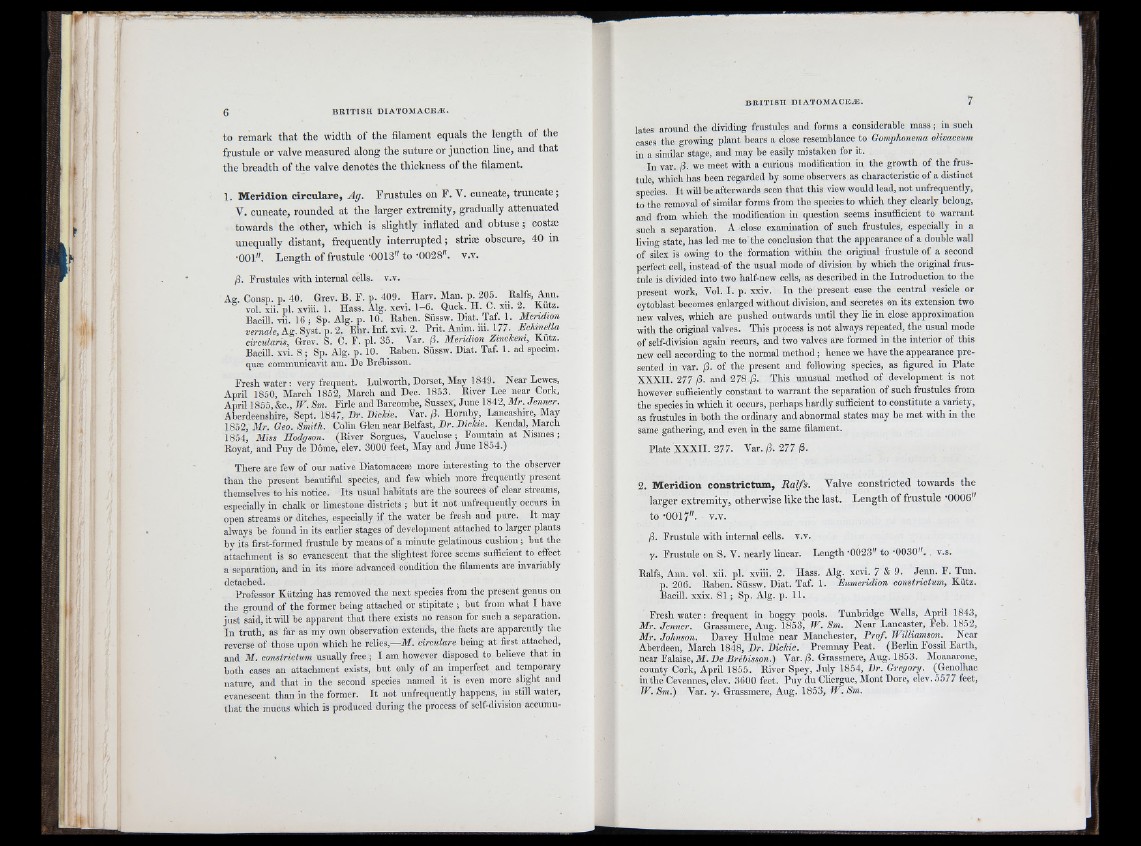
If
J. I
to remark that the width of the filament equals the length of the
frustule or valve measured along the suture or junction line, and that
the breadth of the valve denotes the thickness of the filament.
I. M e rid io n c irc u la re , Ag. Frustules on F. V. cuneate, truncate;
V. cuneate, rounded at the larger extremity, gradually attenuated
towards the other, which is slightly inflated and obtuse ; costæ
unequally distant, frequently interrupted ; striæ obscure, 40 in
•001". Length o ffru s tu le -0013" t o -0028". v.v.
(3. Frustules with internal cells, v.v.
Ag. Consp. p. 40. Grev. B. F. p. 409. Harv. Man. p ./0 5 . Ralfs, Ann.
vol. xii
Bacili.
vernale, —— -------
circularis, Grev. S. C. F. pi. 35. Var. (Ì. Mendion Zmekem, Kutz.
Bacili, x-vi. 8 ; Sp. Alg. p. 10. Rahen. Süssw. Diat. Taf. 1. ad specim.
quæ communicavit am. fie Brébisson.
Fresh water : very frequent. Lulworth, Dorset, May 1849. Near Lewes,
April 1850, March 1852, March and Dec. 1853. River Lee near Cork,
* "I — i-, Try- t-i "n* 1 .1 I I — —, 1, ...
1854, Miss Hodgson. (River Sorgues, Vaucluse ; Fountain at Nismes ;
Royat, and Puy de Dôme, elev. 3000 feet. May and June 1854.)
There are few of onr native Diatomaceæ more interesting to the observer
than the present beautiful species, and few which more frequently present
themselves to his notice. Its usual habitats are the sources of clear streams,
especially in chalk or limestone districts ; but it not unfrequently occurs in
open streams or ditches, especially if the water be fresh and pure. It may
always be found in its earlier stages of development attached to larger plants
by its first-formed frustule by means of a minute gelatinous cushion ; hut the
attachment is so evanescent that the slightest force seems sufficient to effect
a separation, and in its more advanced condition the filaments are invariably
detached.
Professor Kützing has removed the next species from the present genus on
the ground of the former being attached or stipitate ; hut from what I have
just said, it will he apparent that there exists no reason for such a separation.
In truth, as far as my own observation extends, the facts are apparently tlie
reverse of those upon which he relies,—M. cirmlare being at first attached,
and M. constrictum usually free ; I am however disposed to believe that in
both cases an attachment exists, but only of an imperfect and temporary
nature, and that in the second species named it is even more slight and
evanescent than in the former. It not unfrequently happens, in still water,
that the mucus which is produced during the process of sclf-dmsion accumulates
around the dividing frustules and forms a considerable mass ; in such
cases the growing plant bears a close resemblance to Gomphonema olivaceum
in a similar stage, and may be easily mistaken for it.
In var. (i. we meet with a curious modification in the growth of the frustule,
which has been regarded by some observers as characteristic of a distinct
species. It will be afterwards seen that this view would lead, not unfrequently,
to the removal of similar forms from the species to which they clearly belong,
and from which the modification in question seems insufficient to warrant
such a separation. A close examination of such frustules, especially in a
living state, has led me to the conclusion that the appearance of a double wall
of silex is owing to the formation within the original frustule of a second
perfect cell, instead of the usual mode of division by which the original frustule
is divided into two half-new cells, as described in the Introduction to the
present work. Vol. I. p. xxiv. In the present ease the central vesicle or
cytoblast becomes enlarged without division, and secretes on its extension two
new valves, which are pushed outwards until they lie in close approximation
with the original valves. This process is not always repeated, the usual mode
of self-division again recurs, and two valves are formed in the interior of this
new cell according to the normal method ; hence we have the appearance presented
in var. ¡Ì. of the present and following species, as figured in Plate
XXXII. 277 (3. and 278 /3. This unusual method of development is not
however sufficiently constant to warrant the separation of such frustules from
the species in which it occurs, perhaps hardly sufficient to constitute a variety,
as frustules in both the ordinary and abnormal states may be met with in the
same gathering, and even in the same filament.
Plate XXXII. 277. Var. (3. 277 |6,
2. Meridion constrictum, Ralfs. Valve constricted towards the
larger extremity, otherwise like the last. Length of frustule -0006"
to -0017". v.v.
/3. Frustule with internal cells, v.v.
y. Frustule on S. V. nearly linear. Length ’0023" to -0030". v.s.
Ralfs, Ann. vol. xii. pi. xviii. 2. Hass. Alg. xcvi. 7 & 9. Jenn. F. Tun.
p. 206. Rahen. Süssw. Diat. Taf. 1. Eumeridion constrictum, Kütz.
Bacill. xxix. 81 ; Sp. Alg. p. 11.
Freshwater; frequent in boggy pools. Tunbridge Wells, April 1843,
Mr. Jenner. Grassmere, Aug. 1853, W. Sm. Near Lancaster, Feb. 1852,
Mr. Johnson. Davey Hulme near Manchester, Prof. Williamson. Near
Aberdeen, March 1848, Dr. Dickie. Premnay Peat. (Berlin Fossil Earth,
near Falaise, M. Be Brébisson.) Var. /3. Grassmere, Aug. 1853. Moauarone,
county Cork, April 1856. River Spey, July 1854, Br. Gregory. (Genolhac
in the Cevennes, elev. 3600 feet. Puy du Cliergue, Mont Dore, elev. 5577 feet,
W. Sm.) Var. y. Grassmere, Aug. 1853, W. Sm.